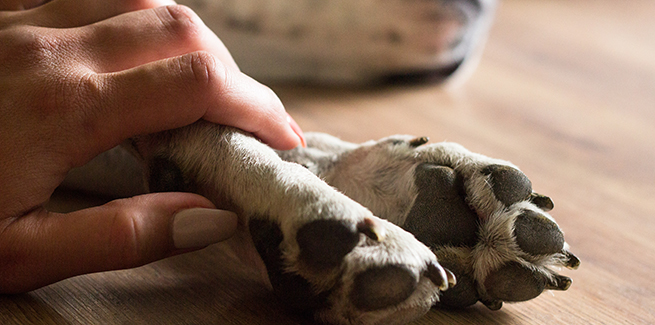First practice receives AAHA’s EOLC accreditation

“Think of things from the pet’s perspective,” said Chelsea McGivney, DVM. “They can just fall asleep in the bed that they love, in a familiar environment, surrounded by loved ones.”
In September 2020, in an effort to help veterinary practitioners elevate end-of-life care for companion animals, AAHA introduced an End-of-Life Care (EOLC) accreditation option for veterinary practices as part of the AAHA Standards of Accreditation.
Last month, Caring Pathways, a mobile euthanasia and in-home hospice and palliative-care practice started in Denver, Colorado in 2010, became the first practice to earn the new EOLC accreditation.
McGivney, Caring Pathways’ general manager, spoke to NEWStat about their new accreditation, and what’s involved in the practice of end-of-life care.
“The accreditation process was wonderful, because it really validated a lot of the processes and procedures that Caring Pathways already had in place,” McGivney said. “Just walking through the different requirements and knowing how many of them we were already meeting was a validation that we’re holding ourselves to that higher standard that’s expected of an AAHA-accredited hospital.”
Given that most of the EOLC-accreditation standards were already SOP at Caring Pathways, McGivney said the biggest change to come with accreditation is the increased amount of annual CE required of the staff, including nonmedical personnel: “AAHA requires that other support staff get end-of-life and grief support CE in addition to the vets, even if they’re not professionally licensed.”
But she sees a big upside in that: “It’s been a great way to offer continuing education for the rest of our staff.”
McGivney said some people don’t understand how veterinarians can devote themselves to what many outside the field might consider an incredibly depressing line of work.
“Until you do this type of work, it’s probably hard to imagine how rewarding it can be,” McGivney said. “It probably sounds very, very sad.”
But McGivney and her colleagues find the work uplifting. “Families are so grateful [to you] for providing such a beautiful passing for their pet, and such a positive end-of-life experience,” she said. “It’s rewarding because you’re really able to foster that human-animal bond.” She said she’s never seen that bond expressed more profoundly than the last goodbyes between a family and their pet who, as far as the family’s concerned, is a family member.
McGivney added that oftentimes, those pets don’t have the quality of life they enjoyed previously, “So making sure that you’re giving them a seamless and smooth and painless goodbye is also rewarding.”
And she points out that EOLC accreditation is about much more than just euthanasia. As the name implies, it’s about care as well, including in-home hospice and palliative care, two services that Caring Pathways provides in addition to in-home euthanasia.
“If a family isn’t ready to say goodbye to the pet or they’re in a place where they don’t necessarily want to continue pursuing expensive diagnostics or therapies, but they want to keep their pet as comfortable as possible, that’s oftentimes when we’ll come in and do a home evaluation.” That involves analyzing the environment and making recommendations on how the pet might be able to get around more easily, or how to keep them more comfortable. “But we’re not typically called in until the pets are at that stage.”
McGivney said that a lot of their business comes from referrals from general-practice veterinarians: “They ask us to take over the care for these end-of-life patients and of course when clients ask them to do at-home euthanasia, which most hospitals don’t do.”
She said the role Caring Pathways plays in hospice care really depends on the pet and how sick they are. “A big part of [what we do] is advising the family on how to provide the care the pet’s going to need to be as comfortable as possible. We’re the ones who create the treatment plan and partner with the family in making sure that the plan can be carried out. “
For instance, the primary veterinarian might recommend daily subcutaneous fluids and for some reason the family’s not able to comply. “We’d come back to the home regularly to help with that.”
AAHA Practice Consultant Margaret Spalletta, who helped shepherd Caring Pathway through the new accreditation process, told NEWStat, “This was a wonderful new learning opportunity for both of us and our goal moving forward is to continue to shine light on this important aspect of patient care and create a positive experience for everyone involved—pet owners, practices, and patients.”
Caring Pathways currently employs 20 mobile veterinarians in Colorado. McGivney concedes that end-of-life care isn’t the right choice for many veterinarians, but some take to it: “Vets who maybe aren’t in love with day-to-day clinical practice any longer, but who really do enjoy supporting families and their pets, and really fostering that human-animal bond.”
McGivney said that AAHA EOLC accreditation “really is something special. I feel very, very proud—and the rest of the team does as well—to be the first AAHA-accredited End-of-Life Care practice. We strive for excellence and try to set the bar really high for ourselves, but we just feel like having this accreditation really helps to set us apart.”
Find out more about AAHA’s EOLC accreditation here.
Photo credit: © sanjagrujic/iStock/Getty Images Plus via Getty Images



